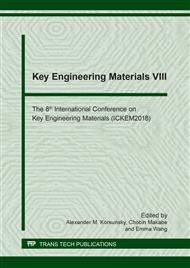[1]
Lihchyi Wen, Chun-hsu Lin, Soo-cheol Lee, Review of recycling performance indicators: A study on collection rate in Taiwan,, Waste Management, 29(8), 2248–2256 (2009).
DOI: 10.1016/j.wasman.2009.03.022
Google Scholar
[2]
David R. Lide, CRC Handbook of Chemistry and Physics,,90th Ed., CD-ROM Version, CRC Press/Taylor and Francis, Boca Raton, (2010).
DOI: 10.1021/ja077011d
Google Scholar
[3]
M.S. Bafghi, A. Zakeri.,Z. Ghasemi, M. Adeli, Reductive dissolution of manganese ore in sulfuric acid in the presenee of iron metal, Hydrometallurgy, 90(2-4), 207-212 (2007).
DOI: 10.1016/j.hydromet.2007.07.003
Google Scholar
[4]
V. Safari, G. Arzpeyma, F. Rashchi, N. Mostoufi, A shrinking particle—shrinking core model for leaching of a zinc ore containing silica,, 93(1), 79-83 (2009).
DOI: 10.1016/j.minpro.2009.06.003
Google Scholar
[5]
G. Belardi, R. Lavecchia, F. Medici, L. Piga Thermal treatment for recovery of manganese and zinc from zinc–carbon and alkaline spent batteries, Waste Management, 32(10), 1945–1951 (2012).
DOI: 10.1016/j.wasman.2012.05.008
Google Scholar
[6]
M. Hasegawa, R. Ueyama, Y. Kashiwaya, T. Hirato, Recovery of Zinc from used alkali-manganese dry cells,, Journal of Sustainable Metallurgy, 1(2), 144-150 (2015).
DOI: 10.1007/s40831-015-0014-8
Google Scholar
[7]
N. Vatistas, M. Bartolozzi, S. Arras, The dismantling of the spent alkaline zinc maganese dioxide batteries and the recovery of the zinc from the anodic material,, J. Power Sources, 101, 182–187 (2001).
DOI: 10.1016/s0378-7753(01)00710-8
Google Scholar
[8]
T. Buzatu, G. Popescu, I. Birloaga, S. Săceanu, Study concerning the recovery of zinc and manganese from spent batteries by hydrometallurgical processes,, Waste Management, 33(3), 699–705 (2013).
DOI: 10.1016/j.wasman.2012.10.005
Google Scholar
[9]
S.M. Shin, G. Senanayake, J. Sohn, J. Kang, D. Yang, T. Kim, Separation of zinc from spent zinc-carbon batteries by selective leaching with sodium hydroxide,, Hydrometallurgy, 96(4), 349–353 (2009).
DOI: 10.1016/j.hydromet.2008.12.010
Google Scholar
[10]
M. Buzatu, S. Săceanu, M.I. Petrescu, G.V. Ghica, T. Buzatu, Recovery of zinc and manganese from spent batteries by reductive leaching in acidic media,, Journal of Power Sources, 247, 612-617 (2014).
DOI: 10.1016/j.jpowsour.2013.09.001
Google Scholar
[11]
G. Senanayake, S-M. Shin, A. Senaputra, A. Senaputra, A. Winn, D. Pugaev, J. Avraamides, J-S. Sohn, D-J. Kim, Comparative leaching of spent zinc-manganese-carbon batteries using sulfur dioxide in ammoniacal and sulfuric acid solutions,, Hydrometallurgy, 105(1-2), 36-41 (2010).
DOI: 10.1016/j.hydromet.2010.07.004
Google Scholar
[12]
B. Zeytuncu, Dissolution of alkaline batteries in reductive acidic media,, Physicochemical Problems of Mineral Processing, 52(1), 437-450 (2016).
Google Scholar
[13]
M. H. Morcali, Reductive atmospheric acid leaching of spent alkaline batteries in H2SO4/Na2SO3 solutions,, International Journal of Minerals, Metallurgy, and Materials, 22(7), 674-681 (2015).
DOI: 10.1007/s12613-015-1121-z
Google Scholar
[14]
K. Provazi, B.A. Campos, D.C.R. Espinosa, J.A.S. Tenório, Metal separation from mixed types of batteries using selective precipitation and liquid–liquid extraction techniques,, Waste Management, 31(1), 59–64 (2011).
DOI: 10.1016/j.wasman.2010.08.021
Google Scholar
[15]
E. Sayilgan, T. Kukrer, N.O. Yigit, G. Civelekoglu, M. Kitis, Acidic leaching and precipitation of zinc and manganese from spent battery powders using various reductants,, J Hazard Mater, 173, 137-143 (2010).
DOI: 10.1016/j.jhazmat.2009.08.063
Google Scholar
[16]
C.Y. Cheng, Purification of synthetic laterite leach solution by solvent extraction using D2EHPA,, Hydrometallurgy, 56(3), 369–386 (2000).
DOI: 10.1016/s0304-386x(00)00095-5
Google Scholar
[17]
Y. Liu, R Xu, Reductive dissolution of MnO2 and manganese oxides in soils by low-molecular-weight organic compounds,, Journal of Environmental Chemistry, 34(6), 1037-1042 (2015).
Google Scholar


